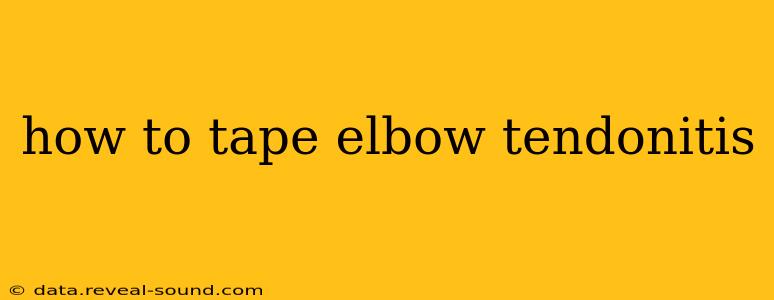Elbow tendonitis, encompassing conditions like golfer's elbow and tennis elbow, can cause significant pain and hinder daily activities. While medical advice should always be sought for diagnosis and treatment, taping techniques can offer effective pain relief and support, helping manage symptoms and aid recovery. This guide explores several taping methods for elbow tendonitis, focusing on practical application and the underlying principles.
What is the Best Way to Tape an Elbow for Tendonitis?
There isn't a single "best" way, as the optimal taping method depends on the specific location and severity of your tendonitis. However, the techniques described below focus on providing support and reducing strain on the affected tendons. The key is to apply gentle, consistent tension without constricting blood flow. Always use high-quality kinesiology tape designed for athletic support.
Understanding Kinesiology Tape
Kinesiology tape, also known as K-tape, is an elastic therapeutic tape that lifts the skin, improving blood circulation and lymphatic drainage. This helps reduce pain and inflammation while providing support to the injured area without restricting movement.
Taping Techniques for Lateral Epicondylitis (Tennis Elbow)
Lateral epicondylitis affects the tendons on the outside of the elbow. Taping focuses on supporting these tendons and reducing strain during movement.
- Anchor Point: Begin by anchoring the tape on the forearm, a few inches below the elbow joint.
- Application: Apply the tape with gentle tension, extending it diagonally upwards across the lateral epicondyle (bony point on the outside of your elbow). The tape should end near the upper arm.
- Overlapping Strips: For added support, apply one or two more overlapping strips in a similar fashion, ensuring each strip has a slight overlap.
- Avoid Over-tightening: The tape should feel supportive but not constricting.
Taping Techniques for Medial Epicondylitis (Golfer's Elbow)
Medial epicondylitis affects the tendons on the inside of the elbow. Taping here mirrors the principles for lateral epicondylitis but targets the opposite side of the elbow.
- Anchor Point: The anchor point is on the forearm, a few inches below the elbow joint, on the inside of the arm.
- Application: Apply the tape with gentle tension, extending it diagonally upwards across the medial epicondyle (bony point on the inside of your elbow) towards the upper arm.
- Overlapping Strips: Again, add one or two more overlapping strips for increased support.
- Avoid Over-tightening: Maintain a comfortable level of support without restricting blood flow.
How Long Should I Keep the Tape On?
You can generally leave the tape on for several days, or even a week, depending on the type of tape used and your individual response. However, if you experience any skin irritation, redness, or increased discomfort, remove the tape immediately.
What are the Benefits of Taping for Elbow Tendonitis?
- Pain Reduction: Taping can help alleviate pain by supporting the affected tendons and reducing strain during movement.
- Improved Proprioception: The tape provides sensory feedback, improving your awareness of your elbow's position and movement, helping prevent further injury.
- Reduced Inflammation: By gently lifting the skin, taping can promote blood circulation and lymphatic drainage, helping reduce inflammation.
- Enhanced Support: The tape provides additional support to the weakened tendons, stabilizing the elbow joint during activity.
Can I Tape My Elbow Myself?
Yes, you can learn to tape your elbow yourself with practice. However, if you are unsure about the correct technique or have difficulty applying the tape, consider seeking guidance from a physical therapist or athletic trainer. They can ensure proper application and customize the technique to your specific needs.
What Other Treatments are Available for Elbow Tendonitis?
Taping is often used alongside other treatments such as:
- Rest and Ice: Avoid activities that aggravate your elbow pain and apply ice packs to reduce inflammation.
- Over-the-Counter Pain Relief: Nonsteroidal anti-inflammatory drugs (NSAIDs) can help manage pain and inflammation.
- Physical Therapy: A physical therapist can guide you through exercises to strengthen your muscles and improve flexibility.
- Corticosteroid Injections: In some cases, a doctor may recommend corticosteroid injections to reduce inflammation.
Disclaimer: This information is for educational purposes only and does not constitute medical advice. Always consult with a healthcare professional before starting any new treatment for elbow tendonitis. They can accurately diagnose your condition and recommend the most appropriate treatment plan.
